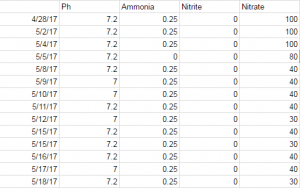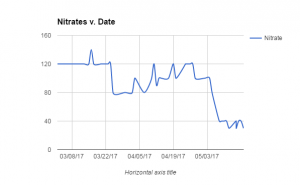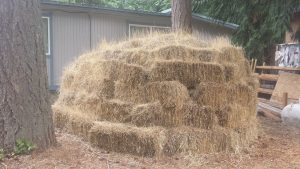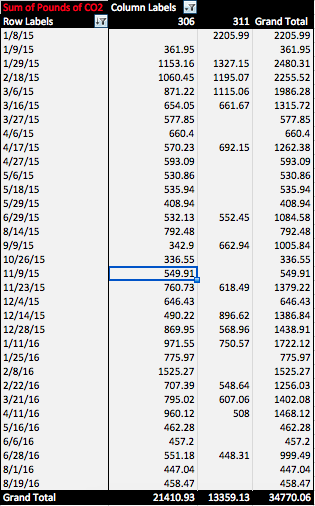Here’s a look at some of our water data from the aquaponics fish tank over last few weeks. Since the installation of the horizontal nutrient system, we have noticed a dramatic drop in our Nitrate levels which have dropped to our more sustainable target zone between 20 and 50 ppm. The graph shows how high the Nitrate levels were prior to the horizontal system, which now holds 32 plants which have been using the excess nitrogen (and using it effectively, our strawberry plants are flowering and close to bearing fruit) to spur growth, and how their consumption has caused a major drop to healthy levels.
Archive for the 'Data' Category
Compost Heat Recovery System
Published September 26, 2016 2016 , Clean Energy Committee , Compost Heat Recovery , Data 1 CommentBy Joe Clevenger and Rhianna Hruska, RAD Sustainability Team.
If you haven’t been there already, go and check out the back side of mod 311 on the lower part of campus. It’s a beautiful area with wood and metal recycling containers, but more importantly, it’s home to a large pile of straw, wood chips, and horse manure. This pile is called a compost heating pile and is actually used for space heating in mod 311! This mod uses propane as a back up heating method and we’ve been collecting propane consumption data on the mods to get a feel for how much carbon dioxide our compost heating pile could potentially offset.
Abstract:
Our compost heat pile consists of 60% wood chips, 30% saw dust, and 10% horse manure. As you can see in the picture above, these resources are piled into a shell of straw bales. The interior resources break down over the course of a year and produce temperatures up to 250˚. The average recorded temperature for the Mod system is between 120˚ and 130˚ F. This heat is harnessed and transferred into water that’s flowing through the pile in PEX tubing. We then take this water and pump it into an in floor radiant heating system that handles space heating in the mod. As hinted at earlier, this heat production slowly decreases over the course of a year and after a full year the entire pile needs to be replaced.
A compost pile is a great way to generate heat without contributing to carbon dioxide emissions. By using compost or other “cleaner” heating sources you can help to offset carbon dioxide. This offset is basically the difference in carbon dioxide emissions between clean energy sources and dirty energy sources. To subvert some of the environmental damages that we’re causing and to maintain a habitable environment on earth, we need to offset as much carbon dioxide as we can.
Analysis:
As stated earlier, Mod 311 uses propane as a backup heating system. For the past two years, we’ve been closely tracking the propane consumption of all the Mods. This has allowed us to compare Mod 311 to Mod 306, which also has an in floor radiant system, but depends solely on propane for heating. After running the numbers, the data showed us that since January of 2015 Mod 306 used about 600 gallons of extra propane as compared to Mod 311. According to eia.gov, every gallon of propane burned emits 12.7 pounds of carbon dioxide (https://www.eia.gov/environment/emissions/co2_vol_mass.cfm). With that math, that 600 gallons of propane equates to 7,200 pounds of carbon dioxide! Below are some pivot tables generated from our raw data to give you a better understanding of this statistic. The first column represents the date the propane tanks were filled, the second columns show how much propane was added to 306 and 311 respectively in gallons, and the last column is the total of both. The propane tanks we have are filled as needed to a standard limit, so when ferrell gas, the company that supplies the propane, comes out the amount they add to the tank is the amount burned from the last fill date to now.
If you want access to our full data set feel free to send an email to radsustainability@evergreen.edu.
Significance:
The obvious significance of this project is the ability to use compost heating to reduce our dependency on fossil fuels. Our climate is becoming more and more unstable as we emit greenhouse gases into our atmosphere. If we can move away from fossil fuels and use more alternative energy sources we can potentially avoid massive storm caused catastrophes, stop different cultures and resources from being eradicated by a rising sea level, as well as avoid conflicts that may arise from depleting global resources.
Another significance of this project is the fact that Gaelan Brown, the VP of marketing at Agrilabs, helped student employees at The Evergreen State College learn about and implement the compost heating pile we now have on campus. Just as we are sharing this information with you now, Agrilabs shared their information with RAD Services and has helped to offset at least a small amount of carbon dioxide. The bigger picture here is that our project and knowledge could be a precursor for other projects like it and we’re planning to collect more data on the compost heating pile to assess the scalability of it.
Our next steps are to install temperature monitors for ingoing and outgoing water for the compost in floor radiant heating system as well as a flow meter for the system. This will allow us to accurately calculate the amount of British Thermal Units (BTUs) the compost pile is producing and to hopefully share that data with students wirelessly.




